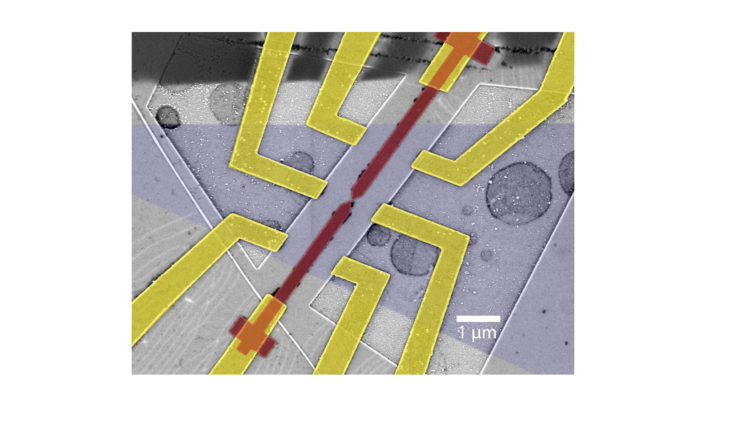
A triangular graphene flake (blue) is cut into a rectangular active area by reactive ion etching. Gold edge contacts are added (yellow) as well as a Pd top split gate (red).
In the early days of graphene, our group published pioneering studies on the effect of a strong magnetic field on the transport of its Dirac-like electrons [1-3]. In recent years, new fabrication techniques have arisen—such as encapsulation by flakes of hexagonal boron nitride—that have pushed the quality of exfoliated graphene devices to the level of ultrapure AlGaAs/GaAs quantum wells. Utilizing the state-of-the-art 2D material fabrication facilities in the Wu lab, we fabricate graphene-boron nitride heterostructures which we then turn into electronic devices at the Princeton Micro and Nano Fabrication Center. We measure these devices down to temperatures < 300 mK and in strong magnetic fields up to 14 T. Our lab also often makes trips to the National High Magnetic Field Laboratory in Tallahassee, FL to conduct experiments in applied magnetic fields > 40 T. Currently, we are interested in the fractional quantum Hall effect and the manipulation of anyonic edge modes.

[1] J.G. Checkelsky, L. Li, and N. P. Ong, Zero-Energy State in Graphene in a High Magnetic Field, Phys. Rev. Lett. 100, 206801 (2008). arXiv:0708.1959.
[2] J. G. Checkelsky and N. P. Ong, Thermopower and Nernst Effect in graphene in a magnetic field, Phys. Rev. B 80, 081413(R) (2009). arXiv:0812.2866v2.
[3] J. G. Checkelsky, L. Li, and N. P. Ong, Divergent resistance at the Dirac point in graphene: Evidence for a transition in a high magnetic field, Phys. Rev. B 79,115434 (2009). arXiv:0808.0906v2.
